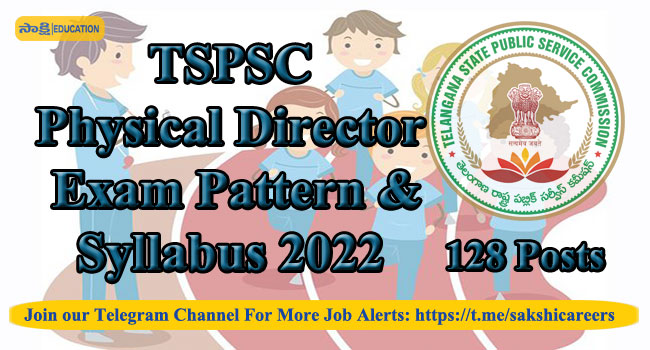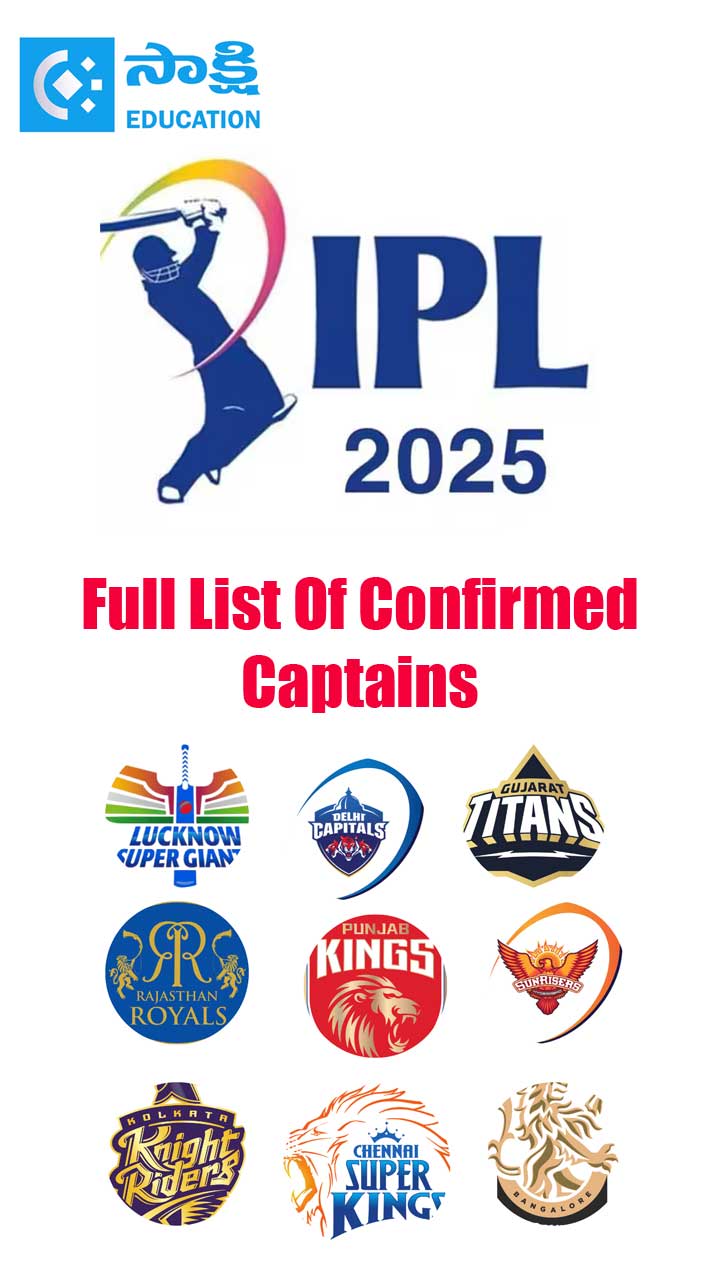TSPSC Physical Director Exam Pattern & Syllabus 2022

TSPSC Physical Director Exam Pattern
TSPSC Physical Director Notification 2022 out; Apply Online For 128 Posts!!!
|
Written Examination (Objective type) |
No. of Questions |
Duration (Minutes) |
Max Marks |
|
Paper – I: General Studies and General Abilities
|
150 |
150 |
150 |
|
Paper – II: Physical Education (M.P.Ed. Level) |
150 |
150 |
300 |
|
Total Marks |
450 |
||
TSPSC Physical Director Exam Syllabus
PAPER-I: General Studies And General Abilities
- Current affairs – Regional, National and International.
- International Relations and Events.
- General Science; India’s Achievements in Science and Technology.
- Environmental issues; Disaster Management- Prevention and Mitigation Strategies.
- Economic and Social Development of India and Telangana.
- Physical, Social and Economic Geography of India.
- Physical, Social and Economic Geography and Demography of Telangana.
- Socio-economic, Political and Cultural History of Modern India with special emphasis on Indian National Movement.
- Socio-economic, Political and Cultural History of Telangana with special emphasis on Telangana Statehood Movement and formation of Telangana state.
- Indian Constitution; Indian Political System; Governance and Public Policy.
- Social Exclusion; Rights issues such as Gender, Caste, Tribe, Disability etc. and inclusive policies.
- Society, Culture, Heritage, Arts and Literature of Telangana.
- Policies of Telangana State.
- Logical Reasoning; Analytical Ability and Data Interpretation.
- Basic English. (10th Class Standard)
PAPER-II: Physical Education (M.P.ED. Level)
RESEARCH PROCESS IN PHYSICAL EDUCATION AND SPORTS SCIENCES
Introduction: Meaning, Definition, Nature, Scope and importance of research in Physical Education. Classification of Research: Basic, Applied and Action Research, Location of Research Problem, Criteria for selection of a Research problem and Qualities of a good researcher. Methods of Research. Descriptive Methods of Research: Survey, Case study. Historical Research, Steps in Historical Research, Sources of Historical Research: Primary Data and Secondary Data, Historical Criticism: Internal Criticism and External Criticism. Experimental Research: Experimental Research: Meaning, Nature and Importance, Variable: Definition, Types of Variables, Experimental Design: Single Group Design, Reverse Group Design, Repeated Measure Design, Static Group Comparison Design, Equated Group Design and Factorial Design. Sampling: Meaning and Definition of Sample and Population. Types of Sampling: Probability Methods: Systematic Sampling, Cluster sampling, Stratified Sampling, Area Sampling and Multistage Sampling. Non-Probability Methods: Convenience Sampling, Judgment Sampling and Quota Sampling. Research Proposal and Report. Chapterization of Thesis/ Dissertation: Front Materials, Body of Thesis, Back materials, Method of Writing Research proposal, Thesis/ Dissertation: Method of writing abstract, full paper for presenting in a conference, publishing in journals, Mechanics of writing Research Report, Footnote and Bibliography.
PHYSIOLOGY OF EXERCISE
Introduction: Skeletal Muscles and Exercise: Definition of Physiology, Exercise Physiology and importance of Exercise Physiology in sports. Macro & Micro Structure of the Skeletal Muscle, Types of Muscle fibers and their characteristics, Chemical Composition, Chemistry of Muscular Contraction, Sliding Filament theory of Muscular Contraction. Muscle Tone, Heat Production in the Muscle and Effects of exercise and training on the muscular system. Cardiovascular System and Exercise. Structure of the Heart, Heart Valves and Direction of the Blood Flow, Conduction System of the Heart, cardiac Circulation, Cardiac Cycle, Heart Rate, Stroke Volume, Cardiac Output and Heart Rate and stroke Volume interactions. Effects of exercise and training on Cardiovascular system. Respiratory System and Exercise. External and Internal Respiration, Mechanism of Respiration, Respiratory Muscles, Minute Ventilation, Ventilation at Rest and During Exercise. Exchange of Gases in Lungs and Tissues, Control of Ventilation, Ventilation and Anaerobic Threshold, Oxygen recovery, Lung Volumes and Capacities, Anatomical Dead Space. Effects of exercise and training on respiratory system. Metabolism and Energy Transfer. Metabolism: Definition and types - Anabolism and Ketabolism, Anaerobic Metabolism: ATP, PC or Phosphagen System, Anaerobic Glycolysis, Aerobic Metabolism: Aerobic Glycolysis, Fat Metabolism. Metabolism during Rest and Exercise (High Intensity, and Long Duration Exercises). Climatic conditions and Ergogenic aids. Variations in Temperature and Humidity – Thermo regulation –Sports performance in hot Cool and humid Climate, high altitude, acclamiatization and circadianrhythm. Ergogenic Aids: Pharmacological, Hormonal, Physiological aspects and their effects on sports performance. Doping and WADA.
APPLIED STATICTICS IN PHYSICAL EDUCATION AND SPORTS
Introduction: Meaning, Definition, types, Functions, need and importance of Statistics. Meaning of the terms, Population, Sample, Data and types of data. Variable: Definition and types of Variables, Discrete and Continuous. Parametric and non-parametric statistics. Measures of Central Tendency Construction of frequency table. Meaning, Definition, Importance, Computation, Advantages and Disadvantages of Measures of central tendency. Mean, median and mode. Measures of Dispersions and Scales. Meaning, Purpose, Calculation and Advantages of Range, Quartile Deviation, Mean Deviation, Standard Deviation, Probable Error. Scales: Meaning, Purpose, Computation and advantage soft – ratio, 6 Sigma scale, Z Scale and Hull scale. Probability Distributions and Graphs. Normal Curve. Principles of normal curve, Properties of normal curve. Meaning of probability – Divergence from normality. Skewness and Kurtosis. Graphical Representations in Statistics: Line diagram, Bar diagram, Histogram, Frequency Polygon, Ogive Curve and Pie Diagram. Inferential and Comparative Statistics Tests of significance, t-test, F-ratio, chi square test, level of confidence and interpretation of data. Meaning of correlation, co-efficient of correlation, calculation of co- efficient of correlation by the product moment method and rank difference method. Concept of ANOVA and ANCOVA.
FITNESS AND LIFESTYLE MANAGEMENT
Concept of Fitness Definition and meaning of Fitness, Different Kinds of Fitness, Physical Fitness, Skill Related and Health Related Physical Fitness. Relationship of fitness and health fitness to develop health of an individual, Wellness revolution: Life style and Health fitness relationship, Meaning of active life style, Physical inactivity and associated health risks Diabetes, Hypertension, Atherosclerosis, Arthritis. Meaning of Health, Health related fitness components: Body Compositions, cardio vascular fitness, Muscular Endurance, strength, flexibility, benefits of health related fitness. Benefits of Health fitness Components: Meaning of health related and Physical fitness components Exercise protocols for the health fitness components, Body Composition, concepts of body weight and components of body weight, Assessment of body composition, Obesity, Meaning of Obesity and risk factors, of Obesity and over fatness-Muscular and joint flexibility-risk factors Associated with poor muscular and Joint flexibility. Nutrition: base for human performance-Carbohydrates, Fats and Proteins. Recommended intake for Normal persons and exercising individuals. Vitamins, Minerals and Water. Osteoporosis and Calcium, Minerals and performance. Optimal nutrition for exercise, Energy value of different important foods, Food Pyramid, fluid replacement before, during and after exercise for temperature regulation and injury prevention, carbohydrates and electrolytes during exercise. Stress – meaning and types of stress, Physical and mental stress-Harmful effects of over training and excessive exercise on health,-mental stress and painful effects of mental stress on health. Anxiety, Depression, insomnia, Compulsive obsessive behaviors, Stress relief through exercise and stress management protocols. Health behavior, Self efficacy and health behavior, Behavioral modification for wellness, Social support and health of an individual, Life style and other related aspects of activity during childhood. Facts on childhood obesity and activity.
YOGIC SCIENCES
Introduction: Meaning, Definition, Scope and importance of Yoga, Essentials For Yoga Practices; Age, Diet, Stomach Emptying bowels, bathing, Clothes, Sun Bathing, No Straining, Place, Time, Awareness, Sequence. Contra indication, Counter Pose, Breathing, and Relaxation. Basic Systems of Yoga with importance - Astanga Yoga: Yama, Niyama, Aasna, Pranayama, Prathyahara, Dharana, Dhyana, Samadhi. Streams of Yoga: Hatha Yoga, Raja Yoga, Karma Yoga, Bhakti Yogaand Gnana Yoga. Aasanas, Kriyas, Bandhas and Mudras: Asana: Definition, Classification, Sitting, Standing, Lying, & Inverted Asanas. Benefits of Asanas, Asanas and Loosening Exercises, Surya Namaskara - Description and Benefits. Kriyas: Meaning, Neti, Nauli, Dhauti, Kapalabhati, Trataka, Bhastrika, Benefits. Bandhas: Jalandhara, Udyana, Mula and Maha Bandha, their Importance. Mudras: meaning, Definition, Purpose, types of Mudras. Pranayama: Meaning, Definition, Tradition, Types, Importance & Impact of Pranayama on naadis. Chakras: Meaning, Definition and types, Effects of Pranayama on major chakras. Meditation: Meaning, Definition and Benefits. Types of Meditation, Passive, active, Saguna and Nirguna Meditation. Meditation and Health, Meditation and stress Management. Concentration: Meaning, Definition and Benefits. Effects of Yoga on Physiological Systems: Respiratory, Circulatory, Digestive, Nervous and Excretory Systems. Place of Yoga as Supplementary, Compensatory, Regenerative and Yogic Power. Role of Yoga in Sports: Promotion of Mental Wellbeing, Role of Yoga in Making out a Sports Person.
SPORTS BIOMECHANICS AND KINSESIOLOGY
Introduction: Meaning, nature, importance and scope of Applied kinesiology and Sports Biomechanics. Meaning of Axis and Planes, Dynamics, Statics, Kinematics, Kinetics, gravity, Center of Gravity, Line of gravity and base of the body. Vectors and Scalars. Muscle Action. Origin, Insertion and action of Muscles around shoulder, Elbow, Hip, Knee and muscles of Abdomen & Trunk. Motion and Force. Meaning and definition of Motion. Types of Motion: Linear motion, angular motion and General motion. Uniform & Non Uniform motion. Laws of Motion: law of Inertia, Law of acceleration and law of reaction. Force: Definition and types of force: Centripetal Force, Centrifugal Force, Sources of force, components of Force, Factors of Force. pressure, friction. Buoyancy and Spin. Projectiles and Levers Freely falling bodies, Projectiles: Principles of Projectiles: Stability, equilibrium and its Types. Factors Effecting on Equilibrium. Definition of Work, Power and Energy. Mechanical Energy: kinetic energy, potential energy and strain energy. Levers: Definition and Types of Levers and their practical application. Mechanical Advantage. Fluid Resistance, Aerodynamics. Movement Analysis. Analysis of Movement: Types of analysis: Kinesiological, Biomechanical. Video Analysis. Methods of analysis – Qualitative, Quantitative, Predictive methods.
TEST, MEASUREMENT AND EVALUATION IN PHYSICAL EDUCATION
Introduction: Meaning and Definition of Test, Measurement and Evaluation. Need and Importance of Measurement and Evaluation. Criteria for Test Selection: Scientific Authenticity, Administrative Considerations and Educational Applications. Scientific Authenticity: Validity, Reliability, Objectivity, Norms, Duplicate Forms and Standard Directions. Physical Fitness Tests Physical Fitness: Meaning and Definition, Physical Fitness Tests: AAHPER, JCR Tests. Roger’s physical fitness Index. Cardio vascular test: Harvard step test, Cooper’s 12 minutes run/ walk test. Motor Fitness Tests. Meaning and Definition of Motor Fitness, Motor Fitness Tests; Indian Motor Fitness Test, Oregon Motor Fitness Test. Motor Ability: Meaning, Definition. Motor Ability Test: Barrow Motor Ability Test, Newton Motor Ability Test. Muscular Fitness: Kraus Weber Minimum Muscular Fitness Test. Anthropometric and Aerobic - Anaerobic Tests. Physiological Test-Aerobic Capacity: Bruce Treadmill Test Protocol, Beep test. Anaerobic Capacity: Margaria - Kalamen test, Anthropometric Measurements: Method of Measuring Height: Standing Height, Sitting Height. Girth: Arm, Waist, Hip, Thigh. Skin Folds: Chest, Abdomen, Mid thigh, Triceps, Illiac Crest. Skill Tests Specific Sports Skill Test: Badminton: French Stalter Short Service Test, MillerWall Volley Test. Basketball: Knox, Johnson Basketball Test. Hockey: Henry Friedel Field Hockey Test, Schmithal’s Field Hockey Test, Volleyball: Russel Lange Volleyball Test, Brady Volleyball Test. Football: Johnson Soccer Test, Mc-Donald Volley Soccer Test. Tennis: Dyer Tennis Test, Broer Miller Test.
SPORTS MANAGEMENT
Meaning and Definition of Sports Management: Meaning – Definition – Scope and concept of management – need and scope of sports management, levels of management – Principles of management – span of control –unity of command. Organization of Physical Education and Budget Scheme of Physical Education Programs in schools, colleges and universities – Districts – States – National – Organization Chartin schools /college level. Budget – Sports Budget - Games Fund – Sources of Income and Expenditure – Approved items of expenditure – Rules for Utilization of games fund for Physical Education programme – Budget preparation and planning in schools and colleges. Maintenance of Records and Equipment etc:- Maintenance of Records and Registers for Physical Education programme and their care maintenance of games equipment - administration and maintenance of track and field –swimming pool–Gymnasium–playgrounds.
Leadership: Meaning and definition of leadership – types of leadership – theories of leadership – qualities and qualifications of a leader, sports leadership. Organization of sports events (Intramurals and extra murals): Intramurals – meaning and definitions – need and importance of intramurals – annual sports day - Writing of circulars, notification and invitations – publicity & public relations –selecting and fixing of officials – monitoring and write ups – press – sponsoring teams –writing reports and maintaining of records. Extra murals – meaning and definitions – need and importance of extra murals – Intercollegiate tournaments – team selections – awards and rewards
SCIENTIFIC PRINCIPLES OF SPORTS TRAINING
Introduction: Sports training: Definition – Aims, Characteristics, Principles of Sports Training. Load: Definition, Components of load. Over Load: Definition, Causes of Over Load, Symptoms of Overload, Remedial Measures for over load – Super Compensation .Recovery. Detraining and Retraining. Components of Physical Fitness. Strength: Meaning, types - Isometric, Isotonic and Isokinetic exercises – Factors determining strength – Methods to improve strength. Speed: Meaning – types – Factors determining speed – Methods to improve speed. Endurance: Meaning – types – Factors determining endurance – Methods to improve Endurance. Flexibility and Coordination: Flexibility: Meaning – types – Factors determining flexibility – Methods to improve flexibility- Coordination: Meaning, types - Factors determining coordination – Methods to improve coordination. Methods of Sports Training Aerobic training, Anaerobic training, Weight training, Fartlek Training, Interval training, Plyometric training, Resistance training, Pressure training, High Altitude training, Functional training, Repetition method of training, and Transfer of training effects. Periodization Training Plan: Micro, Meso and Macro Cycles. Short Term Plan and Long Term Plans - Periodisation: Meaning, Single, Double and Multiple Periodisation, Phases of Periodisation, Preparatory Period, Competition Period and Transition Period. Top form, Tapering performance. Training schedules.
SPORTS MEDICINE, ATHLETIC CARE AND REHABILITATION
Introduction: Meaning, definition and importance of Sports Medicine, Definition and Principles of therapeutic exercises. Injuries: acute, sub-acute, chronic. Advantages and Disadvantages of PRICE, PRINCE (Protection, Rest, Ice, NSAIDS (Non-Steroidalanti inflammatory drugs), Compression & Elevation) therapy, Aquatic therapy. Posture: Posture, Values of Good posture, Causes of Bad posture, Normal curve of the spine and itsutility, Deviations in posture: Kyphosis, lordosis, flat back, Scoliosis, round shoulders, Knock Knees, Bow legs, Flat foot. Causes for deviations and treatment including exercises. Posture test, Gait and types. Rehabilitation Exercises. Passive, Active, Assisted, Resisted exercise for Rehabilitation, Stretching, PNF techniques and principles. Gait training, swiss ball exercises. Massage: Brief history of massage –Massage asanaid for relaxation, Principles of massage, Physiological , Chemical, Psychological effects of massage, Contra indications of Massage, Classification of Massage , Stroking manipulation: Effleurage , Pressure manipulation: Petrissage Kneading (Finger, Kneading, Circular) ironing Skin Rolling, Percussion manipulation: Tapotement, Hacking, Clapping, Beating, Pounding, Slapping, Cupping, Poking, Shaking Manipulation: Vibration and shaking. Sports Injuries Care, Treatment and Support. Principles pertaining to the prevention of Sports injuries–care and treatment of exposed and unexposed injuries in sports, Therapeutics modalities: Cryo, thermo, Hydro, Electro, Actino therapy Strapping, Taping and Bandages, supporting, Aiding techniques for equipment for upper extremities and Lower extremities and spine
SPORTS PSYCHOLOGY
Sports psychology–Meaning–Scope–Need and Importance: Introduction to psychology – sports psychology Meaning, Definition, Nature, need and importance of sports psychology in physical education- Development of sports psychology in India and Abroad - Emotions – Meaning and Definition of emotions - types of emotion, effect of emotion on performance, reasons and control of emotions in sports. Personality and Motivation: Personality – meaning, definition, nature of personality–types of personality – classification of personality – well built sports personality. Motivation – nature, meaning, definition of motivation –need and importance of motivation in sports and games – types of motivation – intrinsic and extrinsic motivation and sports performance. Emotional states and Aggression Emotional states: Aggression – hostility – Aggression, meaning, definition and nature of aggression – role of aggression in sports – types of aggression – degrees/ models of aggression – reasons and control of aggression in sports. Anxiety and Stress: Anxiety- Meaning, definitions, nature, role of anxiety in sports competitions – types of anxiety – reasons and control of anxiety in sports. Stress – Meaning and definitions - physical stress – mental stress – reason and control of stress with physical activity and exercise. Emotional status – Arousal and Activation. Emotional status – Arousal and Activation – meaning, definitions – need and importance of arousal and activation in sports competitions – episodes of activation – drive theory – stages of drive theory – role of drive theory in sports performance - recurrent emotions and cognitive accompaniment to activation in sports.
HEALTH EDUCATION AND SPORTS NURTITION
Health Education: Meaning, Definition of Health, Health Education. Concept, Dimensions, and Determinants of Health. Health Instructions, Aims, objectives and Principles of Health Education. Health Service, Health supervision. II Health Problems in India. Communicable: Tuberculosis, Measles, Mumps, Rabis, Polio, wooping cough, Hepatitis, Ebola, Swine flu, Dengue, Malaria and STD: Gonorrea, HIV/ Aids, Syphilis. And Non Communicable Diseases: Cancer, Asteoporosis, Asthama, Hyper tension, Diabetes. Obesity, Malnutrition, Adulteration in food, Environmental sanitation, Explosive Population, Personal and Environmental Hygiene in schools. Objectives of school health service, Role of health education in schools, Nutritional service, Health appraisal, Healthful school environment, first-aid and emergency care. Health Agencies: Red cross, WHO, St. John Ambulance, UNICEF, UNESCO. Hygiene and Health: Meaning of Hygiene, Types of Hygiene, dental Hygiene, Effect of Alcohol on Health, Effects of Tobacco on Health, Life Style Management, Management of Hypertension, Management of Obesity, Management of Stress. Introduction to Sports Nutrition: Meaning and Definition of Sports Nutrition, Role of nutrition in sports, Basic Nutrition guidelines, Nutrients: Carbohydrate, Protein, Fats, Vitamins, Minerals, Water Dehydration and fluids replacement, Classification of food, organic food, Carbohydrate loading, Hyponatramia., Role of carbohydrates, Fat and protein on Sports Performance. Nutrition and Weight Management. Concept of BMI (Body mass index), Obesity and its hazard, Dieting versus exercise for weight control, Maintaining a Healthy Lifestyle, Weight management program for sporty child, Role of diet and exercise in weight management, Design diet plan and exercise schedule for weight gain and loss.
SPORTS TECHNOLOGY
Sports Technology: Meaning, definition, Importance of technology in Sports, General Principles and purpose of instrumentation in sports, Technological impacts on sports. Science of Sports Materials. Adhesives- Nano glue, nano moulding technology, Nano turf. Foot wear production, Factors and applications in sports, constraints. Foams- Polyurethane, Polystyrene, Styrofoam, closed-cell and open-cell foams, Neoprene, Foam. Smart Materials: Shape Memory Alloy (SMA), Thermochromic film, High – density modeling foam. Surfaces of Playfields Modern surfaces for playfields, construction and installation of sports surfaces. Types of materials: synthetic, wood, polyurethane. Artificial turf. Modern technology in the construction of indoor and outdoor facilities. Use of computer and software in Match Analysis and Coaching. Modern equipment. Playing Equipments: Balls: Types, Materials and Advantages, Bat/Stick/ Racquets: Types, Materials and Advantages. Clothing and shoes: Types, Materials and Advantages. Measuring equipments: Running, Throwing and Jumping Events. Protective equipments: Types, Materials and Advantages. Sports equipment with nanotechnology, Advantages. Training Gadgets. Basketball: Ball Feeder, Mechanism and Advantages. Cricket: Bowling Machine, Mechanism and Advantages, Tennis: Serving Machine, Mechanism and Advantages, Volleyball: Serving Machine, Mechanism and Advantages. Lighting Facilities: Method of erecting Flood Light and measuring luminous. Video Coverage: Types, Size, Capacity, Place and Position of Camera in Live coverage of sporting events. Use of computer and software in mater analysis and coaching.
PRACTICALS:
The following games and sports: Track and field, Swimming, Gymanastics (Artistic and Rhythmic), Football, Tennis, Throwball, badminton, Kho-Kho, shooting, ball badminton, Kabaddi, Hockey, Handball, Cricket, Karate, Judo, Fencing, Tennikoit, Softball, Basketball, Wrestling, Taekwondo, Boxing, Table tennis, volleyball, Aerobics, Yoga, mass demonstration activities like calisthenics, lezium, dumbbells, wands, hoops. For all above: Layout of courts/fields etc if any, rules and officials, lead up games, history, trophies, important personalities, tournaments etc.

















